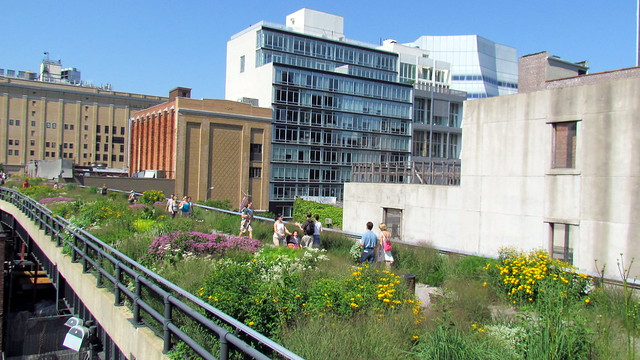 |
| The High line park NYC |
It's hard to believe, but the High Line was once demolished. Fortunately, conscientious citizens came together to create the park you see today instead of demolishing it. Since then, the High Line has become an example for hundreds of other cities and an inspiration for turning unused industrial estates into public spaces. Here are the highlights History of the High Line NYC:
History of the High Line NYC
- Mid-1800s - Freight trains operated by the New York Central Railroad used these functioning railroad tracks to deliver food to lower Manhattan, but this created dangerous conditions for pedestrians. Then 10th Avenue became known as "Avenue of Death". By 1910, over 540 people had been run over by trains here.
- 1920s - due to the growing death rate, the so-called mounted police were hired to warn pedestrians. Until their last trip in 1941, the West Side Cowboys patrolled 10th Avenue, waving red flags to warn of incoming trains.
- 1924 - The West Side beautification project began to materialize, the City Transportation Commission ordered the closure of railroad and pedestrian crossings, which later led to the idea of removing the rails from the streets and creating an overhead rail line.
- 1933 - The first train ran on the High Line, then called the West Side Flyover Line. The line was fully operational by 1934, transporting millions of tons of meat, dairy products and foodstuffs. The tracks ran right through some buildings, such as the Nabisco National Biscuit Company, now Chelsea Market.
- 1960s - 80s - The use of trains declined due to the growth of freight traffic. The southernmost section of the High Line, from Spring Street to Bank Street, was destroyed in the 60s. The decline continued throughout the 70s, and by the 80s the movement had stopped. Calls for the complete demolition of the structure soon followed.
- 1983 - as it was no longer necessary to haul goods on the tracks, new ideas began to appear for using the High Line. Chelsea resident Peter Obletz founded the Westside Rail Line Development Fund in an effort to preserve the structure. That same year, Congress passed a law allowing people to bypass complex land rights issues that include old railroad lines that could be turned into recreational areas.
- 1983 - 1999 - High Line prospects waxed and waned for decades. In 1991, five blocks of the building from Bank Street to Gansevoort Street were demolished when the warehouse was converted into a residential building. In 1999, High Line owner CSX Transportation made proposals for the design to be used.
- 1999 - For decades, many people have referred to the abandoned High Line as an "ugly eyesore". Mayor rudy Giuliani signed an order to demolish the line, one of his last actions in office. But few of these critics have noticed how a graceful garden of wild plants has flourished along the High Line structure. Inspired by the beauty of this hidden landscape, Joshua David and Robert Hammond founded the non-profit Friends of High Line to advocate for the line's preservation and reuse as a public space. Friends of High Line remains the sole group responsible for maintaining and operating the High Line (it is funded by all concerned).
- 2003 - Like-minded group Friends of the High Line organized an idea contest, receiving 720 ideas from over 36 countries on ways to use the park (including ideas that were neither realistic nor practical, such as a roller coaster or a mile-long circular track). At the time, few had heard of the High Line. The competition helped draw attention to this distinctive place.
- 2004 - 2006 - With the active support of Mayor Bloomberg and City Council, a proposal was made to create The West Chelsea Special District and use the High Line as a public park. Team from: landscape architecture firm James Corner Field Operations; design studio Diller Scofidio + Renfro; and floral designer Piet Oudolf was brought together to transform the High Line.
- 2009 - Four years after CSX Transportation transferred ownership to the City of New York, the first section of the High Line was opened to the public from Gansevoort Street to 20th Street. The High Line Art creative organization was founded in 2009 and continues to create and present art works in the High Line Park every year.
- 2012 - 2014 - The second section of the High Line opened from 20th Street to 30th Street. A third section was also planned by the New York City Planning Commission, which opened in 2014 between 30th Street and 34th Street and between 10th Avenue and 12th Avenue.
